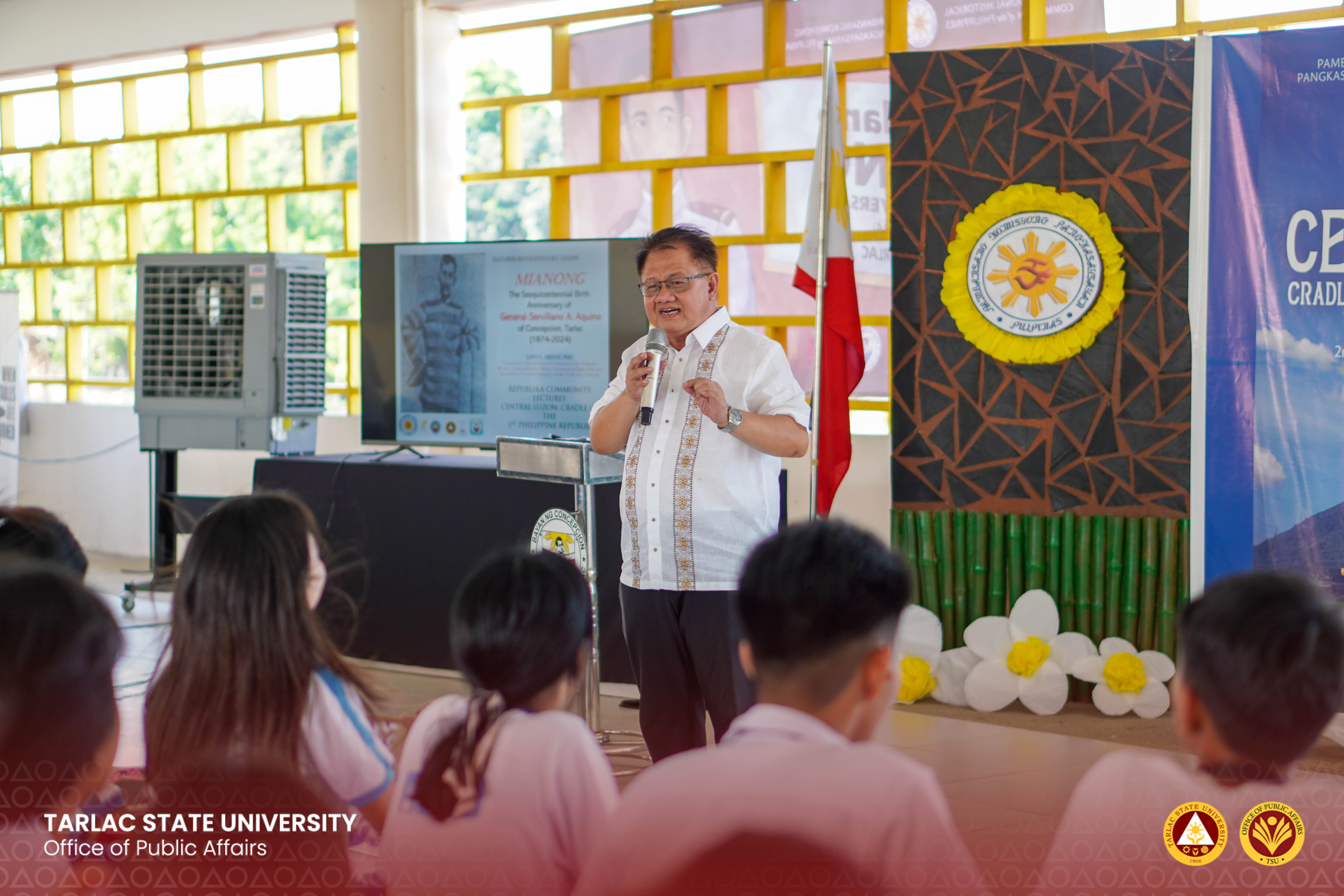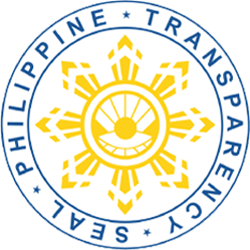Dr. Lino L. Dizon, NHCP Commissioner and retired TSU professor, launched his book about the Tarlac Province on April 19, 2024, which coincided with the lecture celebrating Gen. Servillano Aquino's 150th birth anniversary at the Tarlac State University Concepcion Campus.
The National Historical Commission of the Philippines, along with Tarlac State University, the Local Historical Committees Network, and the local government of Concepcion, organized the book launching and the lecture series that is part of the Republika Community Lectures Central Luzon: Cradle of the 1st Philippine Republic.
Comm. Dizon's book, "The Beginnings of Tarlac Province (1571-1873)," was released through the NHCP following the province's sesquicentennial celebration last May 28, 2023.
"This book will be a part of not just a canon of Tarlaqueño studies but also the canon [of] Kapampangan studies. It will join Dr. Lino's other authoritative book, East Side of Pinatubo, as the two bookends of all the required readings [on] the subject of every day in Tarlac, which is one of the most important and indispensable books of local history; any local history," Dr. Robby Tantingco, Holy Angel University's Center for Kapampangan Studies Director, said in a speech.
The newly published book about the province features new information surrounding Tarlac's history based on documents that are products of research. It also covers a different period, 1571-1873, compared to his 1991 monograph series on Tarlac Studies titled "The Political Evolution of the Province of Tarlac," spanning 1710-1920.
"I am not trying to correct them (early book authors/historians). Bahagi po ito ng pagsusulat. 'Yun po kasing mga ninuno natin na nagsulat noong 1974, dati kasi they celebrated our centennial in 1974. I was a second-year student (then), (mag)kasama na nga kami ni Sir Robby noon at the Mother of Good Counsel Seminary. Noong panahong 'yun talagang 'di pa kumpleto ang mga documents kaya marami pang dokumento na hindi pa nagamit ng mga nagsusulat," Comm. Dizon said.
Dr. Tantingco also said that the commissioner is often underrated in his writing style, having been a poet before becoming a historian, and that Comm. Dizon never stopped being a poet.
"Dr. Lino goes beyond those basic requirements. Dr. Lino injects style, beauty, grace, and precisely his beautifully crafted sentences that make Dr. Lino the historian truly a glass of history," he added.
The Tarlaqueño NHCP Commissioner, hailing from Concepcion, Tarlac, is a member of the Technical Panel for History of the Commission on Higher Education and was the Center for Tarlaqueño Studies Head of TSU until retirement, where he established the Museo-Archivo Tarlaqueño at the Engineering grounds or the exact site of President Emilio Aguinaldo's Casa Real de Tarlac.
Meanwhile, the sesquicentennial birth anniversary event in honor of Gen. Servillano Aquino (1874-April 20, 2024) featured a lecture series from Comm. Dizon about the Filipino revolutionary general and from Mr. Rhonie Dela Cruz of the Bamban Historical Society about Tarlac during the Philippine-American War.
Representing NHCP Chairperson Lisa Guerrero Nakpil was Ms. Gina Camaya Batuhan, Historic Sites and Education Division Chief of NHCP.
"We remember a man who gave much of himself, his wit, his energy, his endurance for Tarlac and for the Filipino people. He continued fighting even when his wife and father-in-law were brutally murdered, as his fellow countrymen stole [from] them. Yet, He continued fighting... The best way to respond [to] his heroism is to remember him and his comrades. Hence, our lecture today," Ms. Batuhan said.
Aside from the lecture, the traveling exhibit by the Local Historical Committees Network and NHCP, "When Tables Are Turned," was opened in line with the 125th anniversary of Philippine Independence and Nationhood (2023-2026).
Showing the university's support, Presidential Assistant Dr. Brigido B. Corpuz, on behalf of the TSU President, retired TSU professor Dr. Rodrigo Sicat, also a local historian from Lubao, Pampanga, and students from the College of Criminal Justice Education, College of Education, and College of Public Administration and Governance attended the activity.
Who is "Apung Mianong"?
According to Comm. Dizon, Servillano Aquino, fondly called "Apung Mianong," was a military governor in the province. He also served as the municipal president of the former town of Murcia in 1890.
He was married to Guadalupe Quiambao, who bore their children, Gonzalo, Amando, and Benigno, the father of the late senator Benigno "Ninoy" Aquino and the grandfather of former president Benigno "Noynoy" Aquino.
Guadalupe, who was pregnant then, and her father, Don Pablo Quiambao, whom she was staying with, were brutally murdered by the Guardia de Honor or "tulisanes," who raided haciendas after another and ransacked their belongings. Despite this, the general continued to serve the country, as Ms. Batuhan mentioned.
In honor of his greatness and service to the province, the Northern Luzon Command of the Armed Forces of the Philippines situated in Tarlac City was named after him (Camp General Servillano Aquino).
The revolutionary governor became a mason member in 1896 and later joined the Katipunan, serving under the "Liberator of Tarlac" Gen. Francisco Macabulos, who organized the Filipino revolutionary forces against the Spaniards.
He is one of the signatories of the Biak-na-Bato Constitution. Yet, not agreeing with Gen. Macabulos on some provisions of the constitution, he was among those who went into exile in Hong Kong with President Emilio Aguinaldo.
Aquino rejoined Macabulos when the fight against Spaniards in liberating Tarlac Province resumed on July 19, 1898. He was then the military governor of Tarlac. This was also the time his wife Guadalupe and father-in-law were assassinated.
He later married his sister-in-law, Petronila, and had a child, Fortunata.
During the Philippine-American War, he was promoted to General and was noted for his valiant defense of Caloocan, together with Gen. Antonio Luna.
After settling in Sitio Pader, Kamansi of Balitucan, Aquino was court-martialed, jailed in Bilibid Prison, and sentenced to be hanged. It was said that his counsel, Gen. Thomas Harigan, appealed to then-US President Theodore Roosevelt for a life sentence. Roosevelt eventually issued him an absolute pardon, and Aquino was released after serving two years and eight months in prison.
After his imprisonment, he chose to live as an ordinary citizen and a consultant to some political affairs. At age 72, he married Belen Sanchez of Concepcion town and had a son (at age 75), Herminio Aquino.
Herminio, popularly known as "Hermie," served the province as vice governor and representative of the third district of Tarlac.
As a congressman, he was instrumental in converting the Tarlac College of Technology into Tarlac State University under Republic Act No. 6764, serving as the co-author of Rep. Jose Cojuangco Jr. of the first district and Rep. Jose Yap of the second district.
The revolutionary hero died at age 84. (jlmm-OPA)
Photo by Eduardo F. Laxamana Jr.








